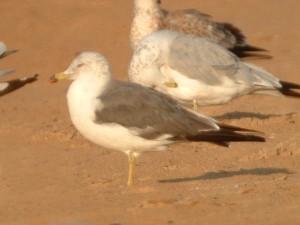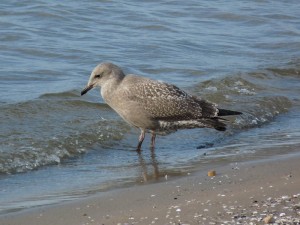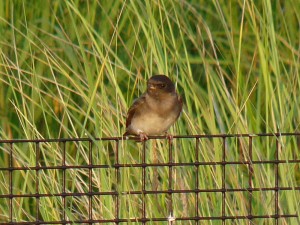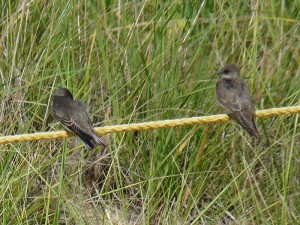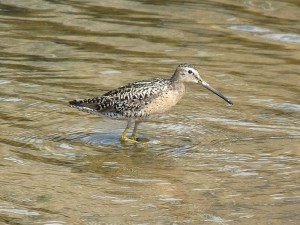I walked around Montrose this morning for a little while. Shorebirds continue to be almost non-existent but I did have a few migrant passerines, including an Orchard Oriole, Least Flycatcher, and Mourning, Black-and-white, and Tennessee Warblers. I’m not sure what’s going on with shorebirds. This is the peak time of the year for them but we’ve had hardly any.
Author Archives: rhughes
Ten Year Anniversary of the Black-tailed Gull
August 7, 2013 is the ten year anniversary of the Montrose Black-tailed Gull. This is my account of that sighting.
Early on the morning of August 7, 2003, Chicago birder Mike Miller was scanning Montrose Beach and noticed an odd dark gull among the local Ring-billed Gulls that had gathered at the west end of the beach. I was standing next to Mike and when I heard him utter the words “There’s a darker backed gull over here” I swung my telescope around to where he was looking and almost immediately saw what looked like an adult Lesser Black-backed Gull. In the back of my mind however I knew this could be the coveted Black-tailed Gull that had been seen as recently as the day before at Miller Beach in Indiana, and several months earlier along the southern Wisconsin lakefront. We were too far away to see the diagnostic red tip to the bill, so with hearts racing and hopes soaring we picked up our scopes and gear and ran over to get a better look at the bird. With closer views the red tipped bill was visible, clinching the identification as a Black-tailed Gull (Larus crassirostris), almost certainly the Black-tailed Gull that had apparently been wandering around Lake Michigan for the past few months. After taking a few dozen photos I made a mental description of the bird: about the same size as a Ring-billed Gull, slaty-gray mantle similar in color to a graellsii Lesser Black-backed Gull (Larus fuscus), yellow legs, yellow bill with a black subterminal band and red tip, and black tail band. Within minutes other birders started to arrive including Montrose regulars Kanae Hirabayashi and John Purcell. I decided that I had enough photos of the bird so I sped home to get word out of the Asian vagrant that was at Montrose Beach. Luckily, the Black-tailed Gull spent several hours at Montrose and, unlike the earlier sightings in Wisconsin and Indiana, was seen by a number of birders. The bird also made the Channel 7 evening news, the Chicago Tribune, and the MSNBC Web site.
The Black-tailed Gull is normally found in the western Pacific Ocean around Japan (Harrison 1983). Indeed, one of the common names of this species is Japanese Gull. There are about 11 records for Alaska and another 9 or so for the rest of North America, including sightings as far south as Belize and as far east as Newfoundland, Canada (Lethaby and Bangma 1998). What makes the Chicago Black-tailed Gull significant is that there is only one previous interior North American record of this species, a bird seen in 1987 at Lake Winnepegosis, Manitoba. Clearly this is not a species that is likely to show up in the Midwest.
Note: This story appeared in Volume 13, Number 2 of Meadowlark, A Journal of Illinois Birds, the quarterly journal of the Illinois Ornithological Society.
Literature Cited
Harrison, Peter 1983. Seabirds, An Identification Guide. Houghton Mifflin Company, Boston MA, 448 pp.
Lethaby, Nick and Jim Bangma 1998. Identifying Black-tailed Gull in North America. Birding 30 (6): 470-483.
First Juvenile Herring Gulls
I had my first juvenile Herring Gulls (3) of the year on July 18. I usually start to see juvenile Herring Gulls about one month after the first juvenile Ring-billed Gulls show up, which is around the third week of June. There were also a couple of Semipalmated Sandpipers on the beach, a few Caspian Terns, including a whistling juvenile, and hundreds of dragonflies over the beach, dunes, and meadow.
Cliff Swallow, July 16, 2013
Several Cliff Swallows have been hanging around the dunes at Montrose with the scads of other swallows. I photographed this juvenile on July 16. Young Cliff Swallows are highly variable in terms of head pattern, much more so than our other regularly occurring swallows. Some can be dark headed like this individual while others can have white spotting on the forehead and throat. The dark head and dark centers to the undertail coverts identify this Cliff Swallow, vis a vis Northern Rough-winged and Barn Swallows.
Northern Rough-winged and Bank Swallow Comparison Photo
Montrose Dunes has been excellent for swallows lately. On July 15 I photographed a juvenile Northern Rough-winged Swallow next to a juvenile Bank Swallow on the yellow rope that cordons off part of the south end of the Dunes. These 2 “brown” swallows can look alike from behind.
In the photo to the right, note the narrow whitish edges to the tertials and primaries and the lack of rufous in the wing coverts of the Bank Swallow (left bird). The juvenile Rough-winged has duller edges to the tertials, and rufous edges to the primaries and wing coverts. The Bank Swallow also has a paler rump than the Roughie and pale edges to the tail feathers. I wasn’t aware of this later feature until I noticed it yesterday, and I’m not sure it’s a completely solid field mark but I didn’t notice it on any of the Rough-winged Swallows I looked at.
Short-billed Dowitchers and Swallows, July 16, 2013
Three Short-billed Dowitchers were at the beach this morning, July 16. Two birds were on the beach inside the protected area and another was feeding in the fluddle next to the Fishhook Pier. The 2 on the beach flew off shortly after I identified them but the bird in the fluddle remained. This bird was present yesterday evening as well. I also had 2 Least and 2 Semipalmated Sandpipers on the beach.
Montrose Dunes has been excellent for swallows lately. This morning I had all 6 of our regularly occurring species either flying around or perched on the yellow rope at the south end of the Dunes. This is a great opportunity to see, study, and photograph these birds, especially when they’re perching on the rope.

